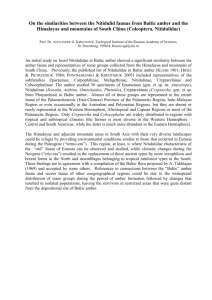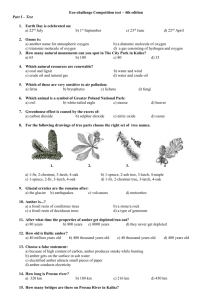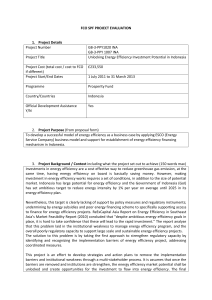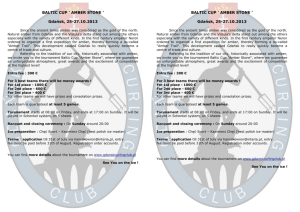Access Web Free of
advertisement
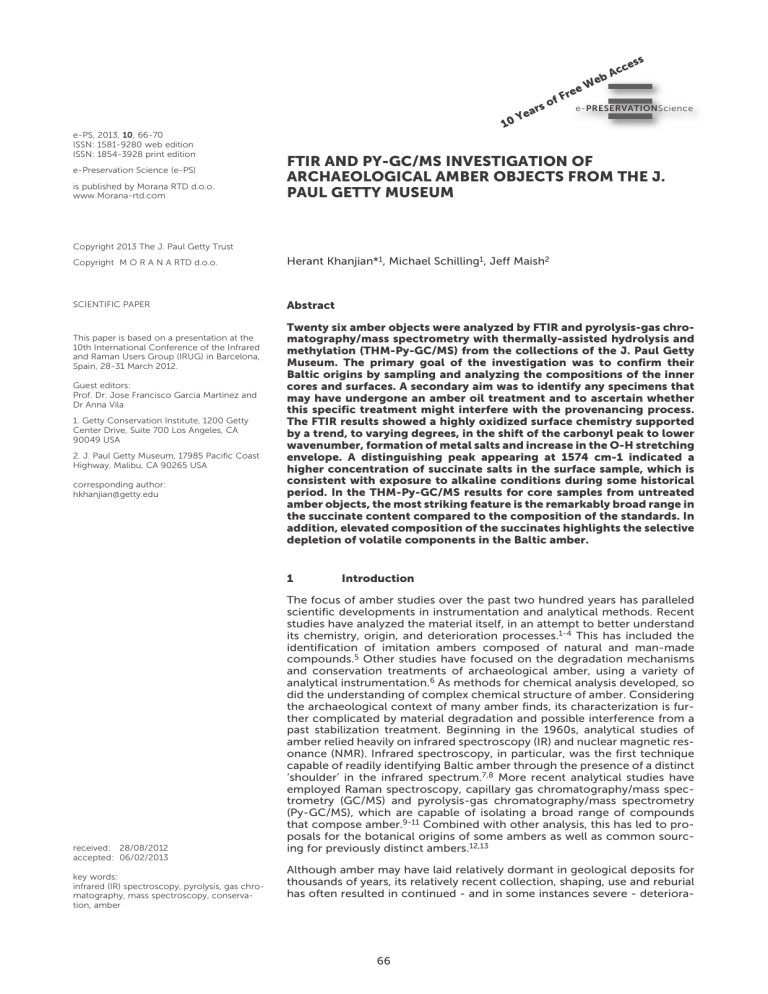
ss ce c bA rs ea e-PS, 2013, 10, 66-70 ISSN: 1581-9280 web edition ISSN: 1854-3928 print edition e-Preservation Science (e-PS) is published by Morana RTD d.o.o. www.Morana-rtd.com of e Fre We e-PRESERVATIONScience Y 10 FTIR AND PY-GC/MS INVESTIGATION OF ARCHAEOLOGICAL AMBER OBJECTS FROM THE J. PAUL GETTY MUSEUM Copyright 2013 The J. Paul Getty Trust Copyright M O R A N A RTD d.o.o. Herant Khanjian*1, Michael Schilling1, Jeff Maish2 SCIENTIFIC PAPER Abstract This paper is based on a presentation at the 10th International Conference of the Infrared and Raman Users Group (IRUG) in Barcelona, Spain, 28-31 March 2012. Guest editors: Prof. Dr. Jose Francisco Garcia Martinez and Dr Anna Vila 1. Getty Conservation Institute, 1200 Getty Center Drive, Suite 700 Los Angeles, CA 90049 USA 2. J. Paul Getty Museum, 17985 Pacific Coast Highway, Malibu, CA 90265 USA corresponding author: hkhanjian@getty.edu Twenty six amber objects were analyzed by FTIR and pyrolysis-gas chromatography/mass spectrometry with thermally-assisted hydrolysis and methylation (THM-Py-GC/MS) from the collections of the J. Paul Getty Museum. The primary goal of the investigation was to confirm their Baltic origins by sampling and analyzing the compositions of the inner cores and surfaces. A secondary aim was to identify any specimens that may have undergone an amber oil treatment and to ascertain whether this specific treatment might interfere with the provenancing process. The FTIR results showed a highly oxidized surface chemistry supported by a trend, to varying degrees, in the shift of the carbonyl peak to lower wavenumber, formation of metal salts and increase in the O-H stretching envelope. A distinguishing peak appearing at 1574 cm-1 indicated a higher concentration of succinate salts in the surface sample, which is consistent with exposure to alkaline conditions during some historical period. In the THM-Py-GC/MS results for core samples from untreated amber objects, the most striking feature is the remarkably broad range in the succinate content compared to the composition of the standards. In addition, elevated composition of the succinates highlights the selective depletion of volatile components in the Baltic amber. 1 received: 28/08/2012 accepted: 06/02/2013 key words: infrared (IR) spectroscopy, pyrolysis, gas chromatography, mass spectroscopy, conservation, amber Introduction The focus of amber studies over the past two hundred years has paralleled scientific developments in instrumentation and analytical methods. Recent studies have analyzed the material itself, in an attempt to better understand its chemistry, origin, and deterioration processes.1-4 This has included the identification of imitation ambers composed of natural and man-made compounds.5 Other studies have focused on the degradation mechanisms and conservation treatments of archaeological amber, using a variety of analytical instrumentation.6 As methods for chemical analysis developed, so did the understanding of complex chemical structure of amber. Considering the archaeological context of many amber finds, its characterization is further complicated by material degradation and possible interference from a past stabilization treatment. Beginning in the 1960s, analytical studies of amber relied heavily on infrared spectroscopy (IR) and nuclear magnetic resonance (NMR). Infrared spectroscopy, in particular, was the first technique capable of readily identifying Baltic amber through the presence of a distinct ‘shoulder’ in the infrared spectrum.7,8 More recent analytical studies have employed Raman spectroscopy, capillary gas chromatography/mass spectrometry (GC/MS) and pyrolysis-gas chromatography/mass spectrometry (Py-GC/MS), which are capable of isolating a broad range of compounds that compose amber.9-11 Combined with other analysis, this has led to proposals for the botanical origins of some ambers as well as common sourcing for previously distinct ambers.12,13 Although amber may have laid relatively dormant in geological deposits for thousands of years, its relatively recent collection, shaping, use and reburial has often resulted in continued - and in some instances severe - deteriora- 66 © by M O R A N A RTD d.o.o. tion. In general, deterioration manifests itself as a thick ‘corrosion’ crust which not only obscures the translucent quality of amber, but may also lead to flaking and loss of the carved surface. In worst-case scenarios, the carved surface completely flakes off, leaving an ambiguously-shaped amber core. Deterioration may continue in a collections environment and be aggravated by pollutants, oxidation processes and inappropriate environmental controls.14,15 Recently, the degradation mechanisms and conservation treatments of archaeological amber have been studied using a variety of analytical instrumentation.6,16,17 logical characteristics of carved amber, organic consolidants may interfere with any future attempts to analyze or classify the amber. Therefore, the consolidation process should be carefully considered and, if carried out, fully documented.18 Thirty five surface and core samples were removed from amber objects and analyzed by FTIR and THMPy-GC/MS. The primary goal of the investigation was to support the drafting of a curatorial catalogue, by the Antiquities Department at the J. Paul Getty Museum, to confirm Baltic origins of a collection of amber objects. A secondary aim was to ascertain whether previous amber oil treatments interfered with the identification process. The selection of THM-Py-GC/MS derivatization procedure was made to improve the detection of labile compounds such as succinic acid and facilitate their identification. The process converts hydroxyl groups of carboxylic acids to their corresponding more stable methyl esters. In the Py-GC/MS chromatograms, individual compounds were identified using the National Institute of Standards and Technology mass spectral database. In an attempt to reinforce fragile amber surfaces, conservators have employed a wide range of consolidative organic materials. A variety of natural and synthetic products have been applied, including amber oil, fats, drying oils and acrylics. While preserving the morpho- 2 Experimental 2.1 Sampling Unweathered particles of amber were removed by drilling from the cores of 26 objects dated from the 7th century B.C. through the 2nd century A.D. Approximately, 0.5 mg of sample was collected from a depth of about 3 mm. In addition to the core samples, surface samples were also removed from seven amber objects in order to better understand the composition of weathered crusts. Figs. 1A and 1B show examples of a better preserved object compared to a highly weathered piece. Tests were also carried out on a number reference materials, including Baltic and Dominican ambers, copal resin, pine resin, sandarac resin and dried residue from amber oil distillate. 2.2 Instrumentation FTIR Optical microscopy was initially utilized to examine sample composition and strategraphy. Representative particles were placed on a one-millimeter thick diamond window and flattened using a metal roller. Polarizing filters were used to enhance sample contrast and assist in targeted analysis. The samples were analyzed on a Nic-plan infrared microscope, equipped with nitrogen cooled MCT/A detector, using a transmitted infrared beam apertured to 200 x 200 μm. The spectra were collected at a sum of 64 scans and of 4 cm-1 resolution. The identification of the infrared spectral data was performed with the help of in-house generated reference libraries. THM-PY-GC/MS Samples were tested on an HP 5972 gas chromatograph/mass spectrometer using a CDS Pyroprobe 2000, fitted with a valved interface at 330 °C and purged with He at 25 ml/min. Samples were placed into quartz tubes fitted with quartz wool, and three microliters of 25% tetramethyl ammonium hydroxide Figure 1: A: Head of a Female Divinity or Sphinx Pendant, Etruscan, 550-520 B.C. The J. Paul Getty Museum, 76.AO.79. B: Female Head Pendant, Italic or Campanian, 500-480 B.C. The J. Paul Getty Museum, 83.AO.202.12. FTIR and PY-GC/MS investigation of archaeological amber, e-PS, 2013, 10, 66-70 67 www.e-PRESERVATIONScience.org (TMAH) in methanol were introduced for derivatization. After 3 min, the tube was placed into a coiled filament probe, which was inserted into the valved interface. After purging for 3 s before pyrolysis, samples were pyrolyzed using the following temperature program: 200 °C for 1 s, then ramped at 10 °C/ms to 700 °C, and held isothermally for 10 s. The split injector was at 340 °C (30:1 ratio), and the MS transfer line was set to 300 °C. A DB-5MS capillary column (30 m x 0.25 mm x 0.25 µm) was used with He at 44 cm/sec. The GC oven temperature program was 2 min at 40 °C, then 6 °C /min to 310 °C, and 13 min isothermal. The solvent delay was 2.5 min. The mass spectrometer was scanned from m/z 35-700. The THM-PY-GC/MS results of core samples from all objects shows a large concentration for succinic acid, a marker peak for Baltic amber, present in the analyzed form of the dimethyl ester derivative at 10.3 min (Fig. 3). Other compounds such as borneol, fenchol, and camphor are present in various amounts, while smaller peaks identified as methyl fenchyl succinate and methyl bornyl succinate appear as constituents of Baltic amber.12 All samples had unusually high amounts of succinic acid relative to the other components, a phenomenon likely arising from particular conditions of burial or treatment, and indicative of selective leaching of certain molecules. 3.2 3 Results and Discussion 3.1 Identification of Amber Weathering and degradation The comparison of core and surface layers revealed interesting information concerning the composition of the ambers, while highlighting the likely burial or treatment conditions that contributed to their degradation. The FTIR analysis of particles from the upper ‘corrosion’ crust showed spectral evidence of hydrolytic induced weathering. This was supported by the appearance of a broad O-H stretching envelope at 3400 cm-1 and a shift in the carbonyl stretching band from 1730 cm-1 to 1700 cm-1, which is a characteristic conversion of esters to carboxylic acids (Fig. 4). There was also evidence of changes in the ester groups that are assigned to the Baltic ‘shoulder’. These included decreases in the C-O groups located at 1250-1150 cm-1 region as well as the exocyclic methylene peaks located at 3080, 1643 and 888 cm-1, which are likely initiated by oxidation or isomerization mechanisms. Conversely, there is noticeable increase in the 1643 cm-1 peak that could not be elucidated but likely caused by the presence of consolidants or weathering by-products. The FTIR identification of amber is based upon the presence of characteristic absorption bands located at 2926, 2867 and 2849 cm-1, attributed to C-H stretching modes of the CH2 and CH3 groups. The carbonyl peaks between 1739 and 1700 cm-1 region are assigned to the ester and acid groups, while bands at 1260 and 1157 cm-1 are assigned to CO-O- modes of the succinate group. Additional peaks located at 3080, 1643 and 888 cm-1 are attributed to the C-H and C=C stretching and bending modes of the exocyclic methylene groups. More importantly, the characteristic distinguishing region attributed to the Baltic “shoulder” variety occurs at 1250-1150 cm-1 due to the activity of axial and equatorial ester groups (Fig. 2).19 Baltic amber Dominican amber Further indications of deterioration was evident in the formation of detectable amounts of metal salts, supported by the appearance of a C-O asymmetric stretching metal carboxylates band at 1573 cm-1 (Fig. 4). The higher concentration of metal carboxylates is indicative of exposure to alkaline environment at some period of time.13 C-O stretch for succinates (Baltic shoulder) The comparison of core and surface layers was further investigated using THM-Py-GC/MS to better comprehend their compositional differences and state of O-H stretching Figure 2: FTIR spectra of Baltic and Dominican ambers. C-H stretching dimethyl succinate C-H bending methyl bornyl succinate C-H stretching TMAH reagent salts C-O stretching C-O stretching methyl fenchyl succinate fenchol camphor camphene borneol Time (minutes) Figure 4: FTIR spectra of core and surface samples from Pendant: Satyr Head in Profile (83.AO.202.1), indicating hydrolysis induced weathering and formation of metal salts. Figure 3: THM-Py-GC/MS results of inner core sample from an ornament fragment (82.AO.161.285), showing the abundance of succinic acid. FTIR and PY-GC/MS investigation of archaeological amber, e-PS, 2013, 10, 66-70 68 © by M O R A N A RTD d.o.o. preservation. Tab. 1 shows the average concentration of succinic and fatty acids found on the surface and core samples from seven amber objects, listing the peak area percentage calculations relative to the total peak area. The depletion of succinic acid is evident and highlights the volatility of the less chemically bound component, while an increase in the fatty acid concentration may indicate evidence of oil or fat media treatments. Succinic acid was found to exist in very small amounts in the amber oil and does not appear to interfere with the detection of the amber marker compounds listed in Fig. 3. Fig. 5 shows the presence of succinic acid in the object but is not observed in the amber oil. The chromatograms in Fig. 6 show examples of amber oil, drying oil and fat treated objects. All chromatograms clearly show the succinic acid peak at 10.3 min. The detection of palmitic and stearic acids, along with the azelaic marker compound found in drying oils, was evident in several objects. Other examples of alternative treatments using fat containing material were detected through the presence of cholesterol compounds, as well as significant peaks for palmitic and stearic acids. Peak Area Percentages Sample Location Average succinate Average fatty acids Core 31 0.3 Surface 14 1.2 Table 1: THM-Py-GC/MS average results of core and surface samples for seven amber objects. 4 3.3 Conservation Treatments Conclusion FTIR and THM-Py-GC/MS analysis confirmed the 26 objects are composed of Baltic amber, both in the surface and inner core layers. The FTIR provided important information regarding the weathering mechanisms and conditions that promoted their formation. While the FTIR method was sensitive to the detection of chemical changes, the PY-GC/MS was responsive to chemical modifications as well as prior conservation treatments. The PY-GC/MS was able to detect the presence of previously applied amber oil and alternative treatments containing oils and fats. The presence of consolidative organic material, such as amber oil previously applied to prevent further deterioration, did not interfere with the identification of the Baltic amber. The depletion of succinic acid in the upper ‘corrosion’ crust indicated a certain degree of hydrolytic weathering most likely caused by the historical burial conditions. Over many decades, restorers and conservators have attempted to reinforce degraded amber surfaces and restore luster, by applying a range of consolidative organic materials. One aspect of the study focused on the interaction of the organic consolidants with the amber objects and their potential interference with the analytical classification. Although some of the museum objects were known to have been treated with amber oil, the analysis was intended to ascertain whether other consolidants were also applied. dimethyl succinate 5 The authors would like to thank their colleague Joy Mazurek, assistant scientist at the Getty Conservation Institute, for her help in collecting the samples. Special thanks to Jerry Podany, head of Antiquities Conservation at the J. Paul Getty Museum and Giacomo Chiari, chief scientist at the Getty Conservation Institute for their encouragement and support. Time (minutes) Figure 5: Py-GC-MS result for surface sample from Plaque: Addorsed Lions’ Heads with Boar in Relief (77.AO.83), an amber oil treated object. azelate The results of this investigation appear in the curatorial catalogue, “Ancient Carved Ambers in the J. Paul Getty Museum”, which may be viewed online at http://museumcatalogues.getty.edu/amber/. In addition, the book “Amber and the Ancient World” by Faya Causey is also available. palmitate stearate 6 succinate Acknowledgements and Note References palmitate stearate 1. Y. Shashoua, M.B.L.D Berthelsen, O.F. Nielsen, Raman and ATR-FTIR spectroscopies applied to the conservation of archaeological Baltic amber, J. Raman Spectrosc., 2006, 37, 1221-1227. cholesterol 2. A. Shedrinsky, T.P. Wompler, N. Indicator, Use of pyrolysis gas chromatography (Py/GC) in the identification of oils and resins found in art and archaeology, Conserv. Cult. Prop. India, 1988, 21, 35-41. Time (minutes) 3. J. Boon, A. Tom, J. Pureveen, Microgram scale pyrolysis mass spectrometric and pyrolysis gas chromatographic characterization of geological and archaeological amber and resin samples, Proceedings of the Second Conference on Amber in Archaeology, Liblice 1990, 9-27. Figure 6: THM-Py-GC/MS for surface samples from treated amber objects. Bottom - Pendant: Female Head in Profile (77.AO.81.4), treated with fat; Middle - Pendant: Female Head in Profile (77.AO.81.30), treated with drying oil; Top - Plaque: Addorsed Lions’ Heads with Boar in Relief (77.AO.83), treated with amber oil. FTIR and PY-GC/MS investigation of archaeological amber, e-PS, 2013, 10, 66-70 69 www.e-PRESERVATIONScience.org 4. A. Shedrinsky, N.S. Baer, The Application of Analytical Pyrolysis to the Study of Cultural Materials, 2nd ed., Applied Pyrolysis Handbook, CRC Press, 2006, 105-131. 5. N. Kalsbeek, K. Botfeldt, Identification of amber and amber imitations by infrared spectroscopy, Meddelelser om konservering no. 1, 2007, 3-11. 6. G. Pastorelli, Archaeological Baltic amber: Degradation mechanisms and conservation measures, Ph.D. Thesis, University of Bologna, 2009. 7. C.W. Beck, E. Wilbur, S. Meret, Infrared Spectra and the Origin of Amber, Nature, 1964, 201, 256-257. 8. C.W. Beck, E. Wilbur, S. Meret, D. Kossove, K. Kermani, The Infrared Spectra of Amber and Identification of Baltic Amber, Archaeometry, 1965, 8, 96-109. 9. R.H. Brody, H.G.M. Edwards, A.M. Pollard, A study of amber and copal samples using FT-Raman spectroscopy, Spectrochim. Acta A, 2001, 57, 1325-1338. 10. M. Feist, I. Lamprecht, F. Muller, Thermal investigations of amber and copal, Thermochim. Acta, 2007, 458, 162-170. 11. G.C. Galletti, R. Mazzeo, Pyrolysis/Gas Chromatography/Mass Spectrometry and Fourier-transform Infrared Spectroscopy of Amber, Rap. Comm. Mass Spectr., 1993, 7, 646-650. 12. J. Poulin, K. Helwig, Class Id Resinite from Canada: A new subclass containing succinic acid, Org. Geochem., 2012, 44, 37-44. 13. K.B. Anderson, J.C. Crelling, Amber, Resinite, and Fossil Resins, ACS Symposium Series 617, 1994, Washington, DC, 21-25. 14. J. Waddington, J. Fenn, Preventive conservation of amber: some preliminary investigations, Coll. Forum, 1988, 4, 25. 15. G. Pastorelli, Identification of volatile degradation products from Baltic amber by headspace solid-phase microextraction coupled with gas chromatography-mass spectrometry, Anal. Bioanal. Chem, 2011, 399, 1347-1353. 16. G. Pastorelli, J. Richter, Y. Shashoua, Photoageing of Baltic amber – Influence of daylight radiation behind window glass on surface colour and chemistry, Polym. Degrad. Stab., 2011, 96, 1996-2001. 17. Y. Shashoua, Degradation and inhibitive conservation of Baltic amber in museum collections, Ph.D. Thesis, Department of Conservation, The National Museum of Denmark, 2002. 18. N. Bromelle, C. Beck, G. Thomson, Authentication and conservation of amber: conflict of interests, in: Science and technology in the service of conservation: preprints of the contributions to the Washington congress, 3-9 September 1982, International Institute for Conservation of Historic and Artistic Works, 1982, 104-107. 19. J.S. Mills, R. White, L.J. Cough, The Chemical Composition of Baltic Amber, Chem. Geol., 1984/85, 47, 15-39. FTIR and PY-GC/MS investigation of archaeological amber, e-PS, 2013, 10, 66-70 70

